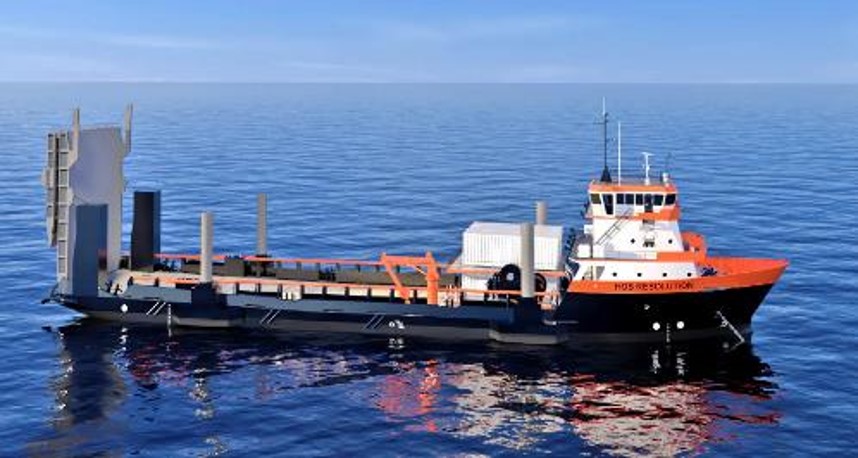
A rendering of a Marine Corps’ Stern Landing Vessel. (Courtesy of the US Marine Corps.)
WASHINGTON — The Marine Corps Warfighting Lab in March expects to receive and begin experimenting with its first Stern Landing Vessel, the warship that will be a precursor to a key new ship design for the implementation of Force Design 2030.
“It’s important to understand why we’re developing the capability like SLV,” said Jeff Tomczak, a senior civilian at the Marine Corps’ Warfighting Laboratory. “It’s primarily because we see a need through our wargaming. We see a need through our modeling and simulation… We see a need for a capability like the SLV that will hopefully become, here in the near future, that capability that’s defined as the Landing Ship Medium.”
Landing Ship Medium is the new vessel introduced by Marine Corps Commandant Gen. David Berger’s Force Design 2030. Berger originally dubbed the vessel a “Light Amphibious Warship,” but the Marines have since renamed it. Its purpose, though, remains the same: A maneuverable and amphibious ship capable of shuttling Marines and their equipment around the first island chain during a conflict with China.
Lt. Gen. Karsten Heckl, the Marine Corps’ senior requirements officer, said during the West 2023 conference in San Diego earlier this month that the service envisions building a fleet of 35 LSMs, giving each Marine Littoral Regiment access to nine ships, while having the rest cycling through maintenance.
RELATED: Lack of amphibs is a training issue, says Marine Corps assistant commandant
“There’s a demand and there’s a need to be able to move things in and around the Pacific because primarily what makes things different in the Pacific than anywhere else we’ve operated recently is the fact that it’s predominantly water,” said Tomczak.
The Stern Landing Vessel program is an interim capability the Marine Corps is funding for experimentation purposes until it more clearly defines all the requirements for its Landing Ship Medium. During a call with reporters on Monday, Tomczak and Lt. Col. Tim Smith, a senior officer at MCWL overseeing the SLV program, said the Marines currently plan to acquire three SLVs.
The first vessel is under contract with Hornbeck Offshore Services and is being leased with an option for the Marines to eventually buy it if desired. The service has the funding for two more ships, to be acquired in fiscal 2024, but the contractor for the second and third SLVs has not yet been determined, Tomczak and Smith said.
Smith described the SLV as a heavily modified offshore support vessel with a 12-foot draft, 6,000 square feet of cargo space and the capacity to hold 38 Marines and a commercial crew of 12-15 mariners.
Importantly for the Marines’ purposes, it will have a large ramp to allow it to hit beaches as well as reinforced materials protecting its rudders and props. Smith said the SLV should be capable of carrying any vehicle in the Marine Corps’ inventory.
The SLV will also be able to support unmanned aerial vehicles, future “subsurface craft” as well as conventional rubber combat craft operations.
Smith said the current experimentation plan is divided into four parts. The first part will focus on testing out how the SLV behaves in differing weather and surf conditions as well as the impact of all the modifications.
“Does it really do everything it says it’s going to do? That’s what we’re going to learn in our in our first 12-week test period… and then we are going to do some limited operational assessment as well,” said Smith.
The second phase will focus on filling out the basic documentation for how the fleet should use the SLVs and get the ships sent out to California and then onto Hawaii for limited operational use with the fleet. It’ll also get some time in use by Force Design 2030’s new unit type, the Marine Littoral Regiment.
“We’re going to develop and refine a lot of concepts of employment tactics, techniques and procedures,” he added.
Phases three and four will focus on integrating the SLVs with the larger Navy and then the larger joint force, Smith said.
“Does it play well with Army vehicles? Does it play well with potential Air Force use?” he added.
Major trends and takeaways from the Defense Department’s Unfunded Priority Lists
Mark Cancian and Chris Park of CSIS break down what is in this year’s unfunded priority lists and what they say about the state of the US military.


























